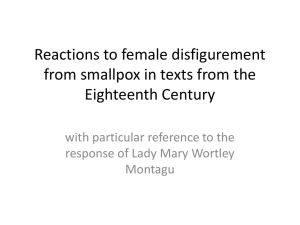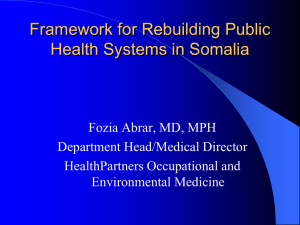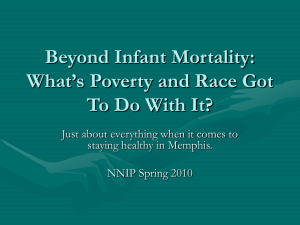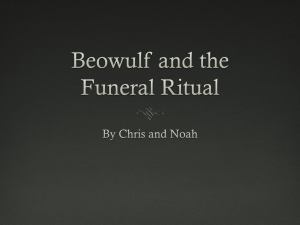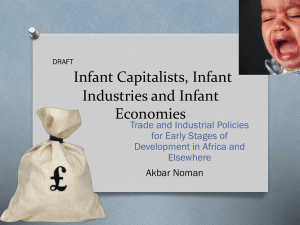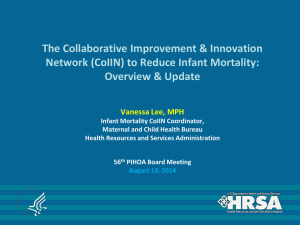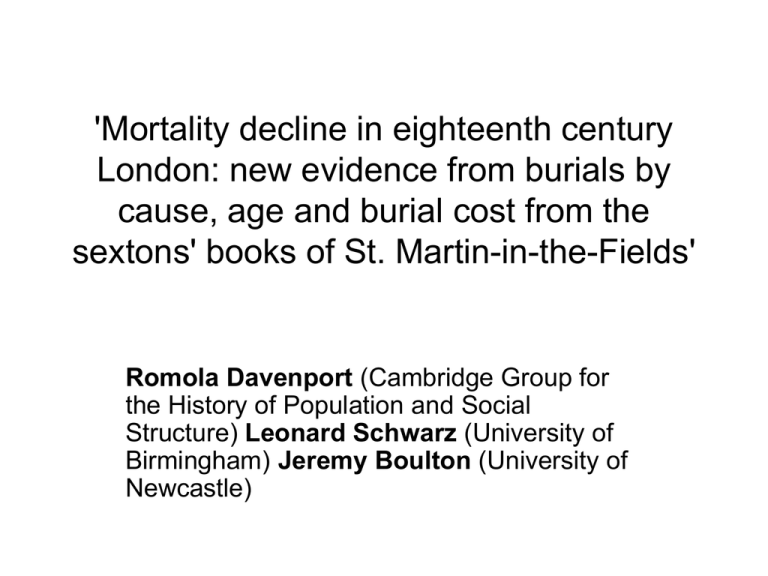
'Mortality decline in eighteenth century
London: new evidence from burials by
cause, age and burial cost from the
sextons' books of St. Martin-in-the-Fields'
Romola Davenport (Cambridge Group for
the History of Population and Social
Structure) Leonard Schwarz (University of
Birmingham) Jeremy Boulton (University of
Newcastle)
The fall and recovery of life expectancy c.16501750 conceals large changes in the age pattern of
mortality
mortality
rates
Infant infant
mortality
rates
infant mortality rate
(deaths/1000 live births)
400
300
200
100
0
1600
Cambridge Group reconstitutions
(including illegitimate)
1650
1700
1750
year
England & Wales
1800
1850
mortality
rates
Infant infant
mortality
rates
infant mortality rate
(deaths/1000 live births)
400
300
London Quakers
200
100
0
1600
Group reconstitutions
(including illegitimate)
1650
1700
England & Wales
1750
year
1800
1850
Non-metropolitan infant mortality (Cambridge
Group reconstitutions)
• Steep decline in endogenous IMR from c. 1750
(heritable and congenital defects, conditions of birth, in
utero conditions)
• Little change in exogenous IMR (mainly infectious
diseases)
Metropolitan infant mortality (London Quakers)
• Steep decline in endogenous IMR after 1750
• Significant decline in exogenous IMR after 1770s
One
year
olds
one
year
olds (1q1)
150
deaths/1000 at risk
125
Very modest improvement after 1760s
(always remaining well above early C17th levels)
100
75
50
England & Wales
25
0
1600
Cambridge Group reconstitutions
(legitimate only)
1650
1700
1750
year
1800
1850
One one
yearyear
oldsolds (1q1)
150
deaths/1000 at risk
125
London Quakers
100
75
50
England & Wales
25
0
1600
Group reconstitutions
(legitimate only)
1650
1700
1750
year
1800
1850
infant mortality rate
(deaths/1000 live births)
Landers’ estimates of infant mortality from
(corrected) London Bills suggest
IMR even higher infant
mortality, and earlier, faster decline
400
300
London Bills
London Quakers
200
100
England & Wales
0
170017201740176017801800182018401860
year
Sources for London
• London Bills:
•
•
•
•
burials by age (deaths under two grouped together)
burials by cause (no ages given)
baptisms
Anglicans only, but increasingly undercount parish register
events after 1760s
• Include stillborn and ‘abortive’ burials
• London Quakers:
•
•
•
•
•
births and deaths
Some information on cause and occupation
Small sample size (max. 1000 individuals in mid-C18th)
Atypical and unstable social composition
Atypical behaviour? (e.g. very low endogenous infant
mortality by early C19th)
St. Martin-in-the-Fields
Population c.25,000 in 1801, c.1000 burials, 700-800 baptisms p.a.
• Sextons’ burial books (1747-1825) record burials by
– Cause
– Exact age (days and weeks for infants)
– Street address
– Burial fee
Include ‘stillborn’ and ‘exported’ burials (1767+)
Don’t include details of parents, for child burials
• Workhouse admission and discharge records (1725-1825)
– admission dates by name, age, sex, and reason
– discharge dates by name and reason
• Baptism fee books record
– graduated baptism fees and pauper exemptions
– date of birth as well as baptism
– Street address
(some of) The problems…
• The population at risk (births)
– Baptisms undercount births
– Under-registration of baptisms increased over the
C18th, due to non-observance and delayed baptism
• Under-counting of deaths
– Burials undercount deaths, esp. infants
– Under-registration may have increased over the
C18th, due to delayed baptism and non-observance
– Traffic in corpses between urban parishes
Correction factors for baptismal under0
recording
may
over-inflate
1750
1760 1770 1780
1790 1800
1810 1820 1830 births in St.
year
Martin-in-the-Fields
births/1000 population
crude birth rate estimates
unadjusted (ex.
stillbirths)
W&S-adjusted
Landers-adjusted
Wrigley &Schofield
50
40
30
St Martin's 1838-41
London 1838-41
England and Wales 1841
20
10
0
1800
1810
1820
year
1841
Birth-baptism intervals, 1760 and 1795
% of baptisms
100
80
60
40
1760
1795
20
0
0
30 60 90 120 150 180 210 240 270 300
age (days)
Only 30-40% of infant burials could be linked to baptisms.
Linkage patterns indicated effects of delayed baptism,
migration and probably baptismal non-observance
% of infant burials linked to baptisms
% of burials linked
60
1760
1795
50
40
30
20
10
0
0
1
2-5
infant age (months)
6-11
The burial market in C18th London
burials per year
1500
‘exports’ identified by ‘fine’ from 1767
exports
imports
'native'
Camden
1000
exports
imports
‘native’
500
‘Imports’ rise with opening of
new burial ground in 1764
Workhouse
burials in
0
Camden Town
1750 1760 1770 1780 1790 1800 1810 1820 1830
year
St. Martin’s burials reported to London Bills were an
accurate report of parish burials (including stillborn), but
excluded exported burials and extra-parochial workhouse
burials
including imports
and exports
including imports
London Bills
burials per year
1500
1000
500
0
1750 1760 1770 1780 1790 1800 1810 1820 1830
year
An overcount of burials?
burials or baptisms
1500
burials
baptisms
infants /1000 burials
1000
500
0
1750 1760 1770 1780 1790 1800 1810 1820 1830
year
Which burials relate to the population at
risk?
• Imported burials were biased by age and sex, and
were excluded from analysis. However c. 5% of
imported infant burials could be linked to a baptism
(vs. c.40% for local burials)
• Exports were biased by sex at adult ages, but
resembled local burials in structure of age and cause
even within the first year of life, except included fewer
stillborn. Included in analysis. Approx. 20% of
exported infant burials could be linked to a baptism
(vs. c.40% of local burials).
•It is likely that exports were higher before 1764, so
their exclusion after 1767 (or correction for exclusion
before 1767) would not ‘correct’ the burial series
Under-recording of infant deaths: does the
pattern by age indicate deficits?
cumulative % of burials
Severe deficit of neonatal burials – almost none aged 0
1752-66
1775-99
1800-11,
1818-24
100
80
60
40
20
0
17
30
91
age, days
183
365
The deficit is restored if stillborn and
abortive burials are included
Stillborns comprised c. 20% of burials aged under one.
cumulative % of burials
1752-66
St. Martin's
no stillborns
100
80
St. Martin's
+ stillborns
Cambridge Group
1750-74
60
40
20
0
17
30
91
age, days
183
365
cumulative % of burials
1775-99
100
St. Martin's
no stillborns
St. Martin's
+ stillborns
Cambridge Group
1775-99
Cambridge Group
1813-17
80
60
40
20
0
17
30
91
age, days
183
365
cumulative % of burials
1800-12, 1818-24
St. Martin's
no stillborns
St. Martin's
+ stillborns
Cambridge Group
1813-18
100
80
60
40
20
0
17
30
91
age, days
183
365
Were most early neonatal deaths described
as stillborn or abortive?
• Extreme deficit of infant deaths at days 0-6, when mortality is
highest
• Sex ratio of stillborn infants similar to early neonatal deaths (160 and
140 males/100 females)
• Very few Chrisom children (16/3418 neonatal burials). ‘Hurt in birth’
11/3418
• If so, was the reason
• Economic? Burial fees cheaper for stillborns and abortives (but also
chrisoms). But stillborns in workhouse (where burials were ‘free’)
comprise similar proportion of neonates to non-workhouse
population. A few ‘stillborns’ identified as early neonatal deaths.
• Fuzziness of stillborn definition?
Inclusion of stillborns inflates St. Martin’s
infant mortality rate
deaths/1000 births
Cambridge Group
London Quakers
St. Martin's
(+ stillbirths)
St. Martin's
(+ stillbirths, no exports)
400
300
200
100
0
1700
1725
1750
1775
year
1800
1825
Endogenous infant mortality
London Quakers
CG low-lying (1675-1749)
St. Martin's (no stillbirths)
CG urban (1675-1749)
St. Martin's (+ stillbirths)
England &Wales
Cambridge Group
deaths/1000 births
150
125
100
75
50
25
0
1725
1750
1775
year
1800
1825
1850
deaths/1000 births
Exogenous infant mortality
London Quakers
St. Martins (no stillbirths)
St. Martin's (+ stillbirths)
Cambridge Group
Cambridge Group
low-lying (1675-1749)
Cambridge Group
urban (1675-1749)
E&W (R-G)
300
200
100
0
1725
1750
1775
year
1800
1825
1850
Does smallpox explain everything?
• Amongst London Quakers, smallpox declined as a cause
of death at all ages in late C18th. The deduction of
smallpox mortality eliminated the late C17th – early
C18th rise in childhood mortality for ages 2-9, and
reduced the rise at ages 0.5-1
• Woods has attributed the C18th decline of maternal and
neonatal mortality and stillbirth rates to the rise and
decline of smallpox mortality in London
Woods R (2009) Death before birth, p.226
Smallpox peaked as a proportion of burials in the Bills in
the 1760s, and declined especially rapidly after 1800
Adults declined as a proportion of smallpox
burials in the late C18th
Percentage of smallpox burials by age
Age
1752-66
1775-99
0
13.7
23.3
1-4
54.5
61.5
5-9
10.9
9.4
10-19
4.6
1.8
20-49
15.6
3.5
50+
0.7
0.6
Mean age at
death (years)
7.8
3.9
Precipitous decline in adult burials in 1770s
% of smallpox burials
Adult percentage of burials (ages 10+)
all cause
smallpox
5 year
moving mean
60
50
40
30
20
10
0
1750
1760
1770
1780
year
1790
1800
1810
Similar pattern of decline in adult smallpox in
St. Martin’s and Stepney (East End)
% smallpox
10+
Adult percentage of
burials (ages 10+)
% of smallpox burials
35
30
25
20
15
St Dunstan's
St Martin's
10
5
0
1750 1760 1770 1780 1790 1800 1810 1820 1830
year
Adult decline accompanied by a rise in infant
smallpox
Total and smallpox infant mortality rates
30
400
300
20
200
IMR
smallpox IMR
100
0
1750
1760
1770
1780
year
1790
1800
10
0
1810
smallpox burials
/1000 baptisms
burials
/1000 baptisms
500
Smallpox
became concentrated at youngest
0
0 1 2 3 4 5 6 7 8 9
ages
age
Percentage of smallpox burials under ten, by year of age
1752-66
1775-99
% of smallpox burials
aged under 10
30
St Dunstan's 1775-99
20
10
0
0
1
2
3
4
5
6
7
8
9
age
Significant difference by Kolmogorov-Smirnov test, for smallpox but not measles
50
s
IMR
smallpox IMR
0
0
Smallpox
declined as a cause of death
in
1750 1760 1770 1780 1790 1800 1810
older children,year
but rose in infants
% of all burials
Smallpox percentage of all burials
45
40
35
30
25
20
15
10
5
0
1752-66
1775-99
0
1
2
3
4
5
age
6
7
8
9
These data are consistent with an increase in
transmission of smallpox within London and nationally
• A fall in adult smallpox risk may have contributed to the decline of
endogenous infant (and maternal) mortality in London after 1770
• An increase in infantile smallpox would have raised exogenous
infant mortality (as may have occurred in St. Martin’s in the late
C18th), before vaccination.
• Does the rapid fall in exogenous mortality of infants and children
amongst the London Quakers (and the very low endogenous
mortality) suggest early adoption of smallpox variolation?
• If so, why does the London Bills infant mortality rate appear to fall so
fast in the late C18th (since variolation was not widespread)?
• A concentration of smallpox mortality at youngest ages nationally
would have favoured mortality decline in later childhood and young
adulthood, while disadvantaging younger children.
Further work
• Baptisms by fee (population at risk by baptism fee
category – infant mortality by social status)
• New correction factors for London Bills
• Seasonality of infant and child deaths
all smallpox
smallpox <10
10
8
6
4
2
au
g
se
pt
oc
t
no
v
de
c
ju
l
fe
b
m
ar
ap
r
m
ay
ju
n
0
ja
n
% of annual burials
12
month


